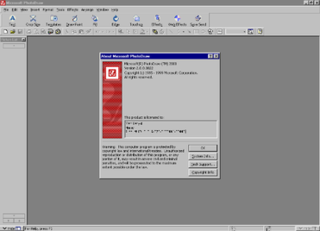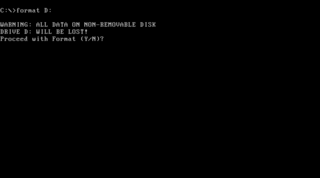| Developer(s) | Hypercube Engineering, Monkey Byte Development |
|---|---|
| Stable release | 4.2 / 2005 |
| Operating system | AmigaOS, MS-DOS, Windows, MacOS |
| Platform | Amiga, IBM PC, Macintosh |
| Type | Scenery generator |
| License | Proprietary |
VistaPro is 3D scenery generator for the Amiga, Macintosh, MS-DOS, and Microsoft Windows. It was written by John Hinkley as the follow-up to the initial version, Vista. [1] [2] The about box describes it as "a 3-D landscape generator and projector capable of accurately displaying real-world and fractal landscapes." It was published by Virtual Reality Labs and developed by Hypercube Engineering. [3] [1] The latest versions were published and developed by Monkey Byte Development. [4]
Vista operates similarly to a ray tracer in that light paths are generated. The user specifies light sources, and camera angles. The ground may be colored to create different ground styles. Vista has water, tree and cloud effects, making some images almost photorealistic. The ground itself may either be generated from a random (or user inputted) number, or it may use DEM landscape files for real-world views, the software having come with a number of maps of Mars and Earth. [5] [6]
Vista can load and save output images in PCX, BMP, JPG and Targa file formats. PCX files can also be imported as elevations and ground colors to allow third-party creation of landscapes in other image editors.
Trees can be placed on landscapes as either 2D or 3D objects. In 2D, the trees always face the camera and are fast to generate. 3D trees are created using fractals and can be given a variable bending of the branches to make them look more complicated.
For Amiga:
For MS-DOS and Microsoft Windows:
For Macintosh:
The Amiga version of Vista works on all models of Amiga, however due to the low processor speeds generation of landscapes take a long time to complete. It was not unusual for a landscape generation to take several hours on a stock 68000 based computer. Later versions, for 32-bit Amigas, support the MC68881/68882 FPU, speeding up rendering considerably when such a chip is present.
The PC version runs in MS-DOS for the earlier versions, and from 4.00 onwards it runs on all versions of 32-bit Microsoft Windows.
Its most famous use was for the landscape used in the opening credits of The Chart Show. This sequence involved a silver spaceship flying through a series of valleys that had been generated using VistaPro (Vista didn't support generating animations until the Pro version was released). Vista was also used (both PC and Amiga versions) for the book by Arthur C. Clarke called "The Snows of Olympus", a picture book about terraforming Mars. [25] [26] [27] The 1994 album "Landscapes" by the Susumu Hirasawa's experimental group Shun was inspired by and used images created in the software. [28]
PCX, standing for PiCture eXchange, was an image file format developed by the now-defunct ZSoft Corporation of Marietta, Georgia, United States. It was the native file format for PC Paintbrush and became one of the first widely accepted DOS imaging standards, although it has since been succeeded by more sophisticated image formats, such as BMP, JPEG, and PNG. PCX files commonly stored palette-indexed images ranging from 2 or 4 colors to 16 and 256 colors, although the format has been extended to record true-color (24-bit) images as well.

Deluxe Paint, often referred to as DPaint, is a bitmap graphics editor created by Dan Silva for Electronic Arts and published for the then-new Amiga 1000 in November 1985. A series of updated versions followed, some of which were ported to other platforms. An MS-DOS release with support for the 256 color VGA standard became popular for creating pixel graphics in video games in the 1990s.

Microsoft Paint is a simple raster graphics editor that has been included with all versions of Microsoft Windows. The program opens, modifies and saves image files in Windows bitmap (BMP), JPEG, GIF, PNG, and single-page TIFF formats. The program can be in color mode or two-color black-and-white, but there is no grayscale mode. For its simplicity and wide availability, it rapidly became one of the most used Windows applications, introducing many to painting on a computer for the first time.

WinRAR is a trialware file archiver utility for Windows, developed by Eugene Roshal of win.rar GmbH. It can create and view archives in RAR or ZIP file formats, and unpack numerous archive file formats. To enable the user to test the integrity of archives, WinRAR embeds CRC32 or BLAKE2 checksums for each file in each archive. WinRAR supports creating encrypted, multi-part and self-extracting archives.
Forest Kenton Musgrave was a professor at The George Washington University in the USA. A computer artist who worked with fractal images, he worked on the Bryce landscape software and later as CEO/CTO of Pandromeda, Inc. developed and designed the innovative MojoWorld software.

Microsoft PhotoDraw 2000 is a discontinued vector graphics and raster imaging software package developed by Microsoft.
A camera raw image file contains unprocessed or minimally processed data from the image sensor of either a digital camera, a motion picture film scanner, or other image scanner. Raw files are named so because they are not yet processed and therefore are not ready to be printed, viewed or edited with a bitmap graphics editor. Normally, the image is processed by a raw converter in a wide-gamut internal color space where precise adjustments can be made before conversion to a viewable file format such as JPEG or PNG for storage, printing, or further manipulation. There are dozens of raw formats in use by different manufacturers of digital image capture equipment.
The Amiga computer can be used to emulate several other computer platforms, including legacy platforms such as the Commodore 64, and its contemporary rivals such as the IBM PC and the Macintosh.
Amiga software is computer software engineered to run on the Amiga personal computer. Amiga software covers many applications, including productivity, digital art, games, commercial, freeware and hobbyist products. The market was active in the late 1980s and early 1990s but then dwindled. Most Amiga products were originally created directly for the Amiga computer, and were not ported from other platforms.

Synfig Studio is a free and open-source vector-based 2D animation software. It is created by Robert Quattlebaum with additional contributions by Adrian Bentley.
PC Paintbrush was a graphics editing software created by the ZSoft Corporation in 1984 for computers running the MS-DOS operating system.

NeoPaint is a raster graphics editor for Windows and MS-DOS. It supports several file formats including JPEG, GIF, BMP, PNG, and TIFF. The developer, NeoSoft, advertises NeoPaint as "being simple enough for use by children while remaining powerful enough for the purposes of advanced image editing".
This article deals with productivity software created for the Amiga line of computers and covers the AmigaOS operating system and its derivates AROS and MorphOS and is a split of main article Amiga software. See also related articles Amiga Internet and communications software, Amiga music software, Amiga programming languages, and Amiga support and maintenance software for other information regarding software that run on Amiga.

In computing, format, a command-line utility that carries out disk formatting. It is a component of various operating systems, including 86-DOS, MS-DOS, IBM PC DOS and OS/2, Microsoft Windows and ReactOS.
3D computer graphics software refers to programs used to create 3D computer-generated imagery.

Fractal-generating software is any type of graphics software that generates images of fractals. There are many fractal generating programs available, both free and commercial. Mobile apps are available to play or tinker with fractals. Some programmers create fractal software for themselves because of the novelty and because of the challenge in understanding the related mathematics. The generation of fractals has led to some very large problems for pure mathematics.
GrafX2 is a bitmap graphics editor inspired by the Amiga programs Deluxe Paint and Brilliance. It is free software and distributed under the GPL-2.0-only license.

Pro Tennis Tour 2 is a sports video game developed by Blue Byte Software for the Amiga and published by Ubisoft in 1991. It is the sequel to the 1989 ZX Spectrum game Pro Tennis Tour. Pro Tennis Tour 2 was ported to MS-DOS compatible operating systems and the Atari ST.